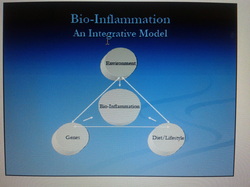
Dr. Qutab began his talk by explaining a bit about NF-kappaB. NF-kB is a protein complex that controls the transcription of DNA. It is found in almost all animal cell types and is involved in cellular responses to stimuli such as stress, cytokines, free radicals, ultraviolet irradiation, oxidized LDL, and bacterial or viral antigens. NF-kB is in the cytosol where it is made inactive by Inhibitory kappaB. However, exposure to stressful stimuli activates inhibitory kappaB kinase, which destroys the IkB. Once destroyed, the NF-KB is able to bind with DNA. The genes within the DNA then encode for increased production of inflammatory materials. Thus far, diseases such a MS, Lupus, IBS, and the like have been associated with the activation of NF-KB.
The triggers for the activation of NF-kB are stress, radiation, injury, leaky gut, food and environmental allergies, vitamin D deficiency, among others. A person's total toxic exposure is comprised of physical sources (injury), nutritional sources, chemical sources (xenobiotics, organics), and infection (endo- and exotoxins). Exotoxins are such things as pesticides, synthetic materials, synthetic medicines, additives, etc.
Thus, the goal is to modulate inflammatory mediators in order to halt the pro-inflammatory genes that activate enzymes and cytokines to create inflammation and disease.
Dr. Qutab also spoke briefly on NSAIDS and why he does not suggest them for EDSers. NSAIDS block the pathways to build cartilage. He is also strongly in favor of Vioxx staying off of the market. He believes that the treatment for pain and inflammation should be as follows:
--remove ongoing triggers
--optimize GI health
--identify potential antecedents
--modify mediators
--introduce an anti-inflammatory diet
--optimize fatty acids and eicosanoid synthesis
--get enough vitamin D
--phytonutritional modulation of NF-KB
--restore structural integrity and remove subluxation
--chrondo support
--botantical angelgesics: white willow bark, boswellia, Devil's claw, etc.
--proteolytic enzymes for acute/chronic pain and inflamation (curcumin, etc.)
His PowerPoint can be found here

 RSS Feed
RSS Feed